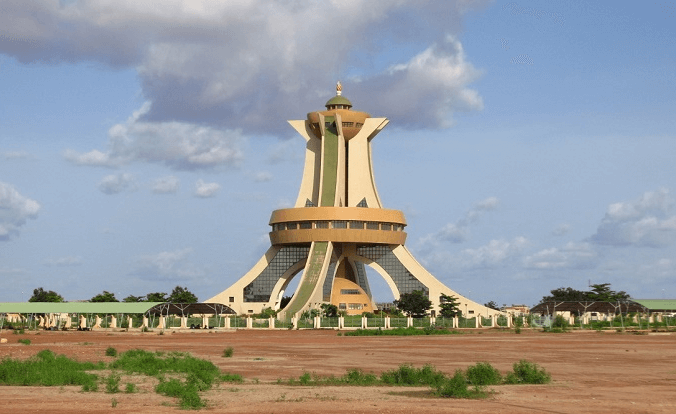This article will delve into the topic of the Burkina Faso National Monument, a tribute to the nation's heroes. Burkina Faso, a landlocked country located in West Africa, is known for its rich cultural heritage and historical significance. The article will provide a detailed exploration of the monument's historical, architectural, cultural, and symbolic aspects, as well as its impact on tourism, the local economy, and national pride.
Burkina Faso, formerly known as Upper Volta, gained its independence from French colonial rule in 1960. Since then, the nation has witnessed significant historical events and heroic acts by its citizens. To honor and commemorate these national heroes, the Burkina Faso National Monument was erected.
The Burkina Faso National Monument, also known as the Monument of National Heroes, stands as a symbol of remembrance and gratitude to the brave men and women who have contributed to the nation's progress and independence. The monument is located in the capital city, Ouagadougou, and has become an iconic landmark representing the spirit of Burkina Faso.
Historical Significance of the Burkina Faso National Monument
The Burkina Faso National Monument holds significant historical value as it pays tribute to the nation's heroes and their contributions to the country's development. It commemorates individuals who fought for independence, social justice, and human rights, leaving an indelible mark on Burkina Faso's history.
Architectural Features and Design
The monument's architectural design is a masterpiece that reflects the nation's cultural heritage and values. It combines traditional elements with modern aesthetics, creating a visually striking structure. The use of local materials and craftsmanship adds to the authenticity and cultural significance of the monument.
Cultural and Symbolic Representations
Beyond its architectural features, the Burkina Faso National Monument holds deep cultural and symbolic meanings. It serves as a unifying symbol for the nation, bringing together people from different ethnic backgrounds and reinforcing the sense of national identity. The monument also represents unity, strength, and resilience in the face of challenges.
Preservation and Maintenance of the Burkina Faso National Monument
To ensure the longevity of the monument, preservation and maintenance efforts are paramount. Burkina Faso's government, in collaboration with cultural organizations and experts, has implemented measures to safeguard the monument against natural elements and human impact. Regular inspections, repairs, and conservation practices are conducted to maintain its structural integrity.
Visitor Experience and Tourism
The Burkina Faso National Monument attracts tourists from around the world who are interested in the country's history and cultural heritage. Visitors can explore the monument, learn about the heroic figures it commemorates, and appreciate the artistic and architectural aspects. The monument serves as a significant tourist attraction, contributing to the growth of the tourism industry in Burkina Faso.
Impact on Local Economy
The presence of the Burkina Faso National Monument has a positive impact on the local economy. Tourism generated by the monument brings in revenue and creates employment opportunities for local communities. Additionally, the monument's popularity boosts the hospitality sector, with hotels, restaurants, and souvenir shops benefiting from increased tourist activity.
Public Perception and National Pride
The Burkina Faso National Monument is regarded with great reverence by the public, instilling a sense of national pride and identity. It serves as a reminder of the nation's struggles, achievements, and the sacrifices made by its heroes. The monument has become a symbol of unity and resilience, strengthening the bonds among the Burkinabe people.
Burkina Faso National Monument as an Educational Resource
Apart from its symbolic and cultural significance, the Burkina Faso National Monument serves as an educational resource. It provides a platform for schools, universities, and educational institutions to teach students about the country's history, independence movement, and the heroes who played pivotal roles in shaping Burkina Faso's destiny.
Challenges and Future of the Burkina Faso National Monument
Like any historical monument, the Burkina Faso National Monument faces challenges related to its preservation, funding, and public awareness. The government and relevant stakeholders must address these challenges to ensure the monument's long-term sustainability and continued relevance.
Frequently Asked Questions (FAQs)
Q: Who designed the Burkina Faso National Monument?
A: The monument was designed by renowned architect [Insert Architect's Name].
Q: Can visitors access the interior of the monument?
A: No, the interior of the monument is not open to the public, but visitors can admire its exterior and explore the surrounding area.
Q: Are there any events or ceremonies held at the monument?
A: Yes, the monument serves as a venue for various national events, ceremonies, and cultural festivals throughout the year.
Q: How can I contribute to the preservation of the monument?
A: You can support the monument by visiting and respecting its rules, spreading awareness, and donating to relevant conservation organizations.
Q: What is the best time to visit the Burkina Faso National Monument?
A: The monument can be visited year-round, but it is recommended to check local weather conditions and plan your visit accordingly.
Conclusion
The Burkina Faso National Monument stands as a testament to the nation's history, culture, and the remarkable individuals who have shaped its identity. This iconic structure not only preserves the memory of national heroes but also serves as a source of inspiration, pride, and unity for the Burkinabe people. Through its architectural grandeur and cultural significance, the monument continues to leave a lasting impression on visitors and future generations, ensuring that the stories of Burkina Faso's national heroes are never forgotten.
References:
- "Burkina Faso." World Bank, www.worldbank.org/en/country/burkinafaso.
- "Burkina Faso National Monument." Ministry of Culture, Arts and Tourism, Burkina Faso, www.mcat.gov.bf/monuments/burkina-faso-national-monument.
- "Burkina Faso: History and Culture." Embassy of Burkina Faso, Washington, D.C., www.burkinaembassy-usa.org/history-culture.
- "Preserving Burkina Faso's Cultural Heritage." UNESCO, whc.unesco.org/en/news/1999/.
